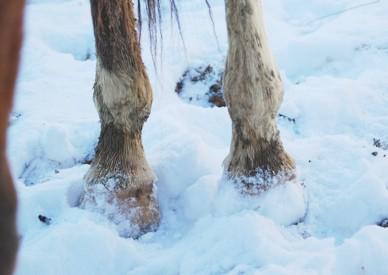Winter Hoof Care For Horses
 By: Taylor Fabus, Michigan State University Extension
By: Taylor Fabus, Michigan State University Extension
Although riding may slow down and visits to the barn become less frequent, caring for your horse in winter should not be overlooked! Proper horse care and management during the winter is essential. The eXtension article “Winter Care for Horses” provides information on complete winter horse care; another, “Basic Horse Hoof Care,” provides information on basic hoof care. As the temperature drops, your horse’s requirements for energy, shelter and hoof care begin to change. Here, we will use resources from eXtension to discover how the winter months specifically affect hoof care.
The same amount of attention should be paid to your horse’s hooves, whether you’re riding regularly or not. This is often one aspect of horse care that’s overlooked in the winter. Horses’ hooves are still growing in the winter months, and they’re walking on frozen, uneven, and sometimes slippery ground, so timely and appropriate farrier work is important. Also, remember to continue to pick hooves regularly to remove dirt and debris, such as rocks and ice.
Hoof care must be kept on schedule throughout the winter. Many horse owners prefer to pull shoes throughout this period of minimal riding. Most horses that are maintained outdoors should have their shoes removed. Shod feet can be-come ice packed, increasing the chance for slipping on snow and ice. Additionally, most horses have better traction on icy ground when shoes are removed. Hooves should be routinely trimmed every six to eight weeks to prevent cracks and breakage. However, care should be taken not to trim them too closely to prevent bruised, sore feet from the frozen ground. Laminitis can occur from trauma to the sole due to walking on rough, frozen ground. Occasionally, if hooves are not maintained throughout the winter and allowed to break off, it may be difficult to have the horse shod when spring comes.
Caring for horses over the winter months can be a difficult task with cold weather, frozen water and strong winds. However, the better horses are maintained during the winter, the better condition they will be in once the weather warms and it is time to start riding again. No matter how difficult the weather, providing appropriate feed, water and shelter for horses is critical.
This article was published by Michigan State University Extension. For more information, visit http://www.msue.msu.edu. To have a digest of information delivered straight to your email inbox, visit http://www.msue.msu.edu/newsletters. To contact an expert in your area, visit http://expert.msue.msu.edu, or call 888-MSUE4MI (888-678-3464).










